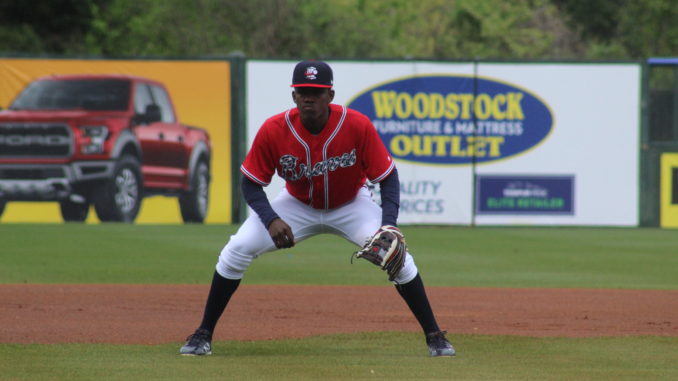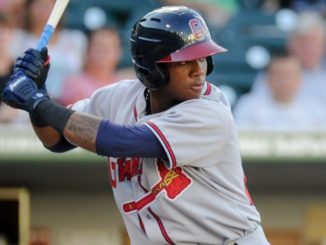
(OFR writers Brent Blackwell, Matt Chrietzberg, and Dylan Short also contributed to this article)
Welcome to what we hope will be a regular weekly feature. We will take a look at the Braves farm system and look at trends and players that seem interesting, and give first hand accounts of what we’re seeing down on the farm. This won’t be a complete weekly round-up of scores and results which can be found in other places (the team web pages for example, or the daily minor league recaps at Talking Chop). Hopefully this will be interesting, hopefully you’ll check in with us Sunday mornings, and hopefully we’ll be able to keep these up throughout the season.
Pitch Counts
One of the biggest differences between this season and last is that almost all starting pitchers in the system seem to be working with generally lower pitch counts so far. Pitch counts were used in prior seasons of course, and were especially stringent on the teenage pitchers in the organization. However, those pitch counts were around 75 to start the season, with older pitchers getting pitch count limits of 85 to start the season.
In the early part of this decade the Toronto Blue Jays were among the teams that were most aggressive in curtailing the amount of pitches and innings thrown by their young pitching prospects. This was following the theory that young players still in their teens and early twenties are still in the process of physical development and that repetitive stress put on the ulnar collateral ligament during these formative years increases the likelihood of tearing that crucial ligament later in their careers. While there is correlating evidence to back this theory, there are believed to be many other contributing factors, but it’s become clear that Braves GM Alex Anthopoulos is still a believer. Currently there is only one teenage pitcher with a full-season Braves affiliate, Freddy Tarnok, and he has pitched only three innings over two relief outings.
For their first starts, all of the Braves affiliate starting pitches aged 22 or less seemed to be on a pitch count of 65, regardless of level. Mississippi’s Kyle Wright (22), Florida’s Bryse Wilson (20), and Rome’s Kyle Muller (20) all finished having thrown exactly 65 pitches, and none of those starters threw more.
In their second starts (and not all of the rotations have turned over yet), it looks like the pitch counts have been raised to 70 or 75. Most of the 22-and-under group pitched into the 70s, with Gwinnett’s Mike Soroka (20) pushing to 78.
The starters aged 23 and older have a separate set of guidelines. Gwinnett’s Lucas Sims (24) and Matt Wisler (25) both had starts of over 80 pitches in their season debuts. Florida’s Jeremy Walker (23) threw 78 pitches in his first start.
Mike Soroka’s pitch counts will be of particular interest. It’s no secret that he was the most impressive pitching prospect in spring training, and it’s been widely speculated that he may be called to Atlanta perhaps as early as May if an opportunity arises. If his pitch counts continue to climb higher than those of his fellow 20-year-old starters, I think you can count on it.
Life on the Farm
ROME: Of the four full-season affiliates, Rome has gotten off to the best start, taking three out of four games from the Hagerstown Suns before dropping two of three to the Charleston RiverDogs. Those two teams are expected to be among the best in the South Atlantic League, so it has been impressive that the relatively inexperienced Rome squad held their own.
The Rome pitching has been paced by the blistering start of Jasseel De La Cruz‘s full-season pro career. De La Cruz in two starts has pitched 10 innings without allowing an earned run while striking out 14 and walking 3. Friend of the blog Wayne Cavadi had a first-person write up of De La Cruz’s second start over at SBNation’s Minor League Ball that is worth the read.
FLORIDA: The going has been a lot tougher for the Fire Frogs early on as they have stumbled to a 2-8 record. The offense hasn’t really clicked yet, and neither have starting pitchers Jeremy Walker and Tucker Davidson, the two older classmen of the Frogs rotation. In fact, the Fire Frogs have a combined 4.54 ERA so far in the young season, despite a combined 12.2 innings of 1-run pitching from Joey Wentz and Bryse Wilson, striking out 14 batters in the process.
One Frogs hitter off to a good start is catcher Brett Cumberland. While many (including yours truly) figured Cumberland would be looked at as an outfielder going forward, the Braves have instead doubled down on his catching. He’s also swatted 3 home runs, tied with Gwinnett’s Carlos Franco for most by Braves minor leaguers so far, and is hitting .313/.405/.656
MISSISSIPPI: The M-Braves started off strong, winning three of their first four, but dropped their next four games since the hot start. The M-Braves pitching staff has been led thus far by Kyle Wright, who pitched 7.2 innings over two starts while allowing only one unearned run, and Max Fried, who pitched 4.2 scoreless innings in his brief pit stop in Mississippi before being promoted to Gwinnett.
The M-Braves hitting has been paced by the top part of the lineup: 3B Austin Riley is hitting .300/.364/.600 with a multi-homer game in Biloxi while playing solid defense, Alex Jackson is batting .333/.417/.571 with a home run at Trustmark Mark that still may not have landed, and Tyler Neslony, who is hitting .400/.406/.467 with five RBI in the early going. Unfortunately, Travis Demeritte has gotten off to a dreadful start, only getting one hit in his first 25 at-bats for a .040/.143/.040 line.
GWINNETT: The Stripers have been swimming upstream due to an anemic offense. All of their games have been close thanks to good starting pitching, but the team is batting only .183/.253/.333 in the early going.
The struggles of top prospect Ronald Acuña, Jr. have been well documented, but veterans Christian Colon, Chris Stewart, Rob Brantly, Danny Santana, Ezequiel Carrera, Rio Ruiz, and Jaff Decker have all stumbled out the gate. Also the other Braves outfield prospect that made a good impression this spring, Dustin Peterson, started the season 5-for-27, and didn’t get his first hit on the season until Thursday. I asked OFR contributor and host of The Platinum Sombrero podcast Dylan Short to take a look at a recent Peterson plate appearance.
He’s not staying compact at all. His backside is the first thing to move every time, and then he steps out with his back leg to boot, which ruins his base. I dont recall seeing him do that this spring, maybe he just wasn’t picking up the ball comfortably.
Prospect Spotlight: Thomas Burrows
In this section I am going to try to highlight a particular Braves prospect, and maybe not necessarily one that gets a whole lot of attention. This week we’re going to look at recently promoted Fire Frogs left-handed reliever Thomas Burrows, who came in at #38 in my off-season Fifty Prospects in Fifty Days series, and #36 in the Composite Prospect List.
Burrows started the season at Rome for the second time, a placement that surprised many due to his success in 2017. It may have just been a case of having so much depth, as Burrows wasn’t the only relief pitcher to start at a level lower than expected. Devan Watts started out in Florida despite having success in Mississippi, and Jason Hursh started the season in Mississippi despite showing out well in Gwinnett in 2017.
Burrows had one outing for Rome before he was promoted to the Florida Fire Frogs. In that outing he pitched two innings, striking out 4 without a walk or hit; he faced one over the minimum due to an error made behind him and clearly demonstrated that he was ahead of the competition he faced in the South Atlantic League. The Braves must have finally agreed because he was a Fire Frog the next time he took the mound. Below is footage I shot of his encounter with Juan Soto, widely regarded as the Nationals #2 prospect in their system and who in the four game series hit .375/.412/.875 with 2 home runs and 6 RBI in the four-game series.
Pitch 1 (0-0): Soto lays off the slider outside. This is the bread-and-butter pitch for Burrows against left-handed batters, a big sweeping slider that dives below the bat. Soto is clearly expecting it, and it dives low for the ball. But it was a quality pitch, and you can see catcher Drew Lugbauer nod to Burrows in encouragement.
Pitch 2 (1-0): Fastball low and away, which Soto also lays off of. Burrows was trying to induce a ground ball to the left side of the infield, where shortstop Riley Delgado was having a strong day in the field.
Pitch 3 (2-0): Woo-boy. Burrows gets away with a poor pitch. He was trying to come inside and low to Soto, and it stayed up. Soto demonstrates his plus bat speed by turning on it, but it goes just foul. It’s strike one, but Burrows and Lugbauer get away with one.
Pitch 4 (2-1): Back to the slider, and this time it catches the corner. This is such a competitive pitch because there’s not much Soto can do with it unless he sells out to look for it and try to drive it opposite field. Soto just saw two consecutive fastballs and had almost got hold of one and was probably looking for another one.
Pitch 5 (2-2): This pitch demonstrates why it’s easier for a hitter to look fastball and adjust to off-speed than vice-versa. Unfortunately for Soto, after seeing that slider drop on the outside corner for a strike, he had to be ready to defend that corner. That made it easy for Burrows to tie him up inside with a two-seam fastball with good vertical drop.
The former University of Alabama closer is one of the top pure relief prospects in the organization. The depth of the organization may make his ascension slower than he and many other observers may wish however, but his demonstrated skills could also make him attractive for a team looking to make a trade with Atlanta.
Transaction Round-Up, with Brent Blackwell
4/8/2018: RHP Elian Leyva transferred from GCL Braves to Mississippi
4/11/2018: RHP Elian Leyva transferred from Mississippi to Danville
4/13/2018: RHP Elian Leyva transferred from Danville to Gwinnett
Elian Leyva exists! In the 2018 Atlanta Baseball Preview book (still available!) I expressed some doubts that Leyva would ever pitch in the Atlanta system. He seemed very much like the kind of international signing John Coppolella might use to hide money. After all, a rather tepid career in the Serie Nacional wasn’t exactly begging to be tested in America. Lo and behold, Leyva is not only finally making his American debut, but is looking somewhat decent in the process. Obviously, small sample warnings apply, but in 5 2/3 innings, Leyva has allowed 6 baserunners while registering 7 whiffs. He’s 29, which could explain his aggressive placement in the system. If he’s not on the cusp of the majors now, it’s doubtful he ever will be.
4/8/2018: Drew Harrington transferred from Florida to Rome
After one relief appearance, where he allowed 5 baserunners and 3 runs, Harrington was sent to low-A Rome. In two relief appearances with Rome, Harrington has been hit hard there as well. Yes, the sample is small, but until we have some results that verge on encouraging, we’ll keep a concerned eye on Harrington’s statline and hope he can reverse course and head back up the ladder. He experienced some success with Florida last season before being shut down in early July, but both his peripherals and his stuff are cause for pessimism.
4/13/2018: Kade Scivicque released from Gwinnett
When Atlanta’s catching depth chart struggled to survive the opening series against Philadelphia, Atlanta opted to trade for Carlos Perez, a pretty sub-par offensive catcher, rather than call up Scivicque. Scivicque was in spring training with the club, so the higher-ups got a pretty good look at him. When a catcher who slashes .272/.344/.370 in AAA one year doesn’t get the phone call when there’s a bona fide emergency at his position, the writing is pretty much on the wall. Despite we here at Outfield Fly Rule being fans – we placed Scivicque at #28 on our offseason prospect list – there was presumably a big enough red flag with his game to turn off Braves management. With the trade for Perez, it became clear there wasn’t much of a place for Scivicque with this organization. It’s disappointing the team couldn’t get anything for him in a trade, but perhaps the league feels as hesitant about Scivicque as the Braves.
Mailbag Q&A
Thanks to Outfield Fly Rule readers in our Facebook group for the questions!
Q: Why is it called a farm? -A. Sparks
A: The term farm team, or farm system, dates back to the late 1910s. The general manager of the St. Louis Cardinals, legendary baseball pioneer Branch Rickey, was having difficulty signing amateur talent from the various independent minor leagues, as deeper-pocketed teams like the New York Highlanders (later Yankees) and Boston Red Sox were able to offer more to the teams in buy-outs than the Cardinals. Rickey began in 1918 to start buying controlling interests in some minor league teams in order to “cultivate” his own crop of young players to feed the big city club.
Q: Realistically, how soon can we see Riley and Jackson MLB ready? -M. Whiteside
A: I think Austin Riley could probably play major league ball today and not embarrass himself to be honest. However, the front office will wisely look for Riley to continue proving himself. My guess for his timeline is that he could slug his way to Gwinnett by late May/early June. If he continues to play well, he could get a September cup of coffee. If the Coppy/Hart regime were still calling the shots, I do think he would have started the season in Gwinnett with a possible mid-season promotion to Atlanta, but the newer shot-callers have to date shown themselves to be much more conservative.
Jackson may be on a similar schedule, though he has a lot further to go on the defensive side. While he has shown he’s not a butcher behind the plate, he still has a lot of work to put in before he can be considered an average major league receiver. It’s not outside the realm of possibility he could also get a look in Atlanta in September, but I would be a little more surprised than if Riley came up.
Q: We have all heard the popular names Jackson, Soroka, Allard, etc. How about some prospects that are legit and flying under the radar? -S. Miller
A: Rome is really the place right now of under-the-radar prospects. Third baseman JC Encarnacion was rated #27 in the OFR prospect list, and he could push into the 20s with further development; just on the basis of fast hands and great bat-to-ball skills, he’s currently hitting .394/.429/.485 on the young season. If he can learn better pitch selection and clean up some of his mechanics, he could come out from under the radar very quickly. I have also tried to keep my expectations in check for outfielder Jefrey Ramos; he’s undersized (listed at 6′-1″ and 185 pounds, I question that height measurement) but only 19 years old. I like his bat plane and speed, and he’s showing consistent doubles power that could easily turn into over-the-fence power if he continues his physical development. The reason I am trying to temper my expectations is that he’s not especially quick and his glove will keep him to a corner, which will put a lot of pressure on the bat to keep developing.
For pitching, in addition to Jasseel De La Cruz, who was mentioned in the Life On the Farm section above, keep an eye on 19-year-old Freddy Tarnok, a third-rounder out of last year’s draft. His assignment to Rome for Opening Day was perhaps the most aggressive by the organization of any player. He’s only pitched in relief so far to limit his innings, but long-term the Braves will look for him as a starter. He has a deceptively easy delivery, and the fastball has more pop in it than I think hitters are prepared for. He shows good feel for a curve as well. He has some filling out to do with his body, and I think they’ll try to keep him under 70 innings or so this year to keep pressure off the arm. But he’s a good long-term bet.
Q:Â How long do you think Alex Anthopoulos will keep Braxton Davidson? -T. Childers
The easy answer here is that they’ll keep Davidson until they either need his roster spot for a better prospect or another team becomes interested in him enough to trade for him. He’s now playing first base starting his third season at the advanced-A level. This is both a good and bad thing for Davidson. It’s good in that there are far fewer first base prospects in the organization than outfield prospects; the team parted ways with Leudys Baez and Bradley Keller before the start of the season, despite both having displayed growth last season just because of the outfield logjam in the lower minor levels. It’s bad, because the team will no longer showcase Davidson in a more demanding defensive position.
Every season we hear reports out of spring training that Davidson is finally starting to tap into his raw power. To date he has hit a home run; it’s also the only hit he’s had. No competition for the position or not, this is probably a make-or-break year with Davidson. He either will need to move up or move out.





Leave a Reply